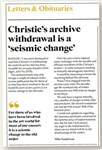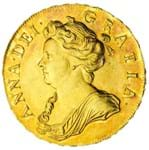While I was fortunate enough to have had the benefit of being born into a family long established in the trade, I count my teenage period as a ‘student porter’ at Christie’s as among my most formative.
While a handful of the passionate connoisseurs who made up the specialist departments in those days remain, regrettably their position appears much diminished.
I will always remember the ecstasy in the porcelain department when a pair of ormolu-mounted Chantilly magots arrived in the warehouse; sales of ‘Fairings, pot lids and Staffordshire figures’ overseen on the floor by the much-teased Albert Watts; avoiding the eye of Jim Taylor, the ferocious foreman porter, when heavy marble slabs had to be carried up the stairs in King Street; my first purchase, as a porter, of an unsold Chinese gouache of a shoe-seller (which I still have); my first conscious exposure to ‘Art Nouveau’; the short-sighted auctioneer who always had to have bids pointed out by the clerk (at that time the inestimable Ray Perman), and so much more – including the pub most lunchtimes.
Each week there were daily sales ranging from those with thin, unillustrated catalogues to ‘Fine’ sales with larger catalogues, and rarely ‘Important’ sales with many illustrations, some even in colour!
Once in a blue moon, there was a ‘Highly Important’ sale. I forget the exact order, but certainly Thursdays were for furniture and Fridays for paintings. This was five a five-day-a-week opportunity to look, see and handle hundreds of objects in a multitude of disciplines – you could not help but learn
We lowly porters stood, anonymously in our green coats, in ‘block outs’ (a square of flat-topped show cases) where we handed over objects to be examined, mainly, by the trade. But here was a wonderful opportunity to learn as experts poured over, say, a Chelsea figure or silver teapot, commenting on its design, weight, colour and condition.
Tricks of the trade
And one noted the tricks of a trade. The comment ‘oh, I don’t much care for this’ might a day or so later be followed by active participation in the bidding at the horseshoe table that surrounded the rostrum.
Friendships were made in those days that remain, including with some of those on the front counter, now sitting in the boardroom.
I remember, in the pre-paddle, pre-registration, pre-phone days one particularly effective auctioneer smiling as I showed reluctance to bid against a reserve: ‘one more bid and its yours, Martin’, and so it was, Duncan.
The old partners were there every day overseeing the well-being of the firm and its staff (‘Mr Guy’ leaning over the balcony watching out for late arrivals); turkeys were handed out at Christmas and the name of the rival ‘up the road’ was sometimes gently ‘spat’ rather than spoken, but all with a dignified civility and humour.
And there was the wonderful coming together of the trade and auction houses in 1973 for ‘Fanfare for Europe’ when we joined the European Economic Community.
Christopher is right: we cannot turn the clock back. But it does no harm to recall that not all the changes are necessarily for the better.
Martin Levy
H Blairman & Sons
London SW1H












